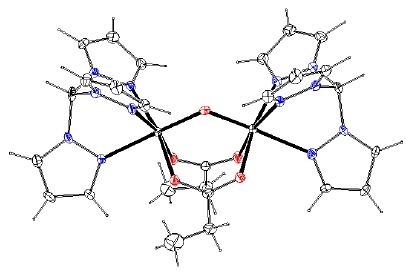The presence of two cobridging propionato ligands forces a bent V-O-V geometry with a 133° bridge angle.
This angle is about 10° larger than typically found in other M(III)-O-M(III) complexes with carboxylate
bridging ligands. The larger angle in this case has been attributed to an increase in orbital energy
with decreasing bridge angle for V(III)-O-V(III) species that resists formation of the bent bridge. The V-O
bond lengths in this structure are about 0.2 A shorter than expected for V-O single bonds, indicating that
there is some multiple bond character in the bridging bonds. The structure is also rich in a variety of
chemical detail, octahedral metal centers, aromatic rings, acetonitrile solvate molecules, among others, that make it
a useful example of many structural motifs that are encounted in crystallography.
Literature reference: Bond, M. R., Czernuszewicz, R. S., Dave, B. C., Mohan, M., Verastgue, R., and Carrano, C. J. "Spectroscopic and Magnetostructural Correlations in Oxo-Bridged Dinuclear Vanadium(III) Complexes of
Potential Biological Significance" Inorg. Chem. 1995, 34, 5857-5869.
Companion Structure: (l-histidinato)4V2O.2H2O
Companion Structure: [(HB(pz)3(mu-CH3CH2CO2)V]2OH.(CH2)4O
Structure Determination Files by FTP
Download X-ray Data Set (propio2.hkl)
Download X-ray Data Collection Parameters (propio2.p4p)
Download Final Refinement Results (propio2.res)
Last changed December 7, 1996
Return to Instructional X-Ray Data Sets Page
Return to Main Page

